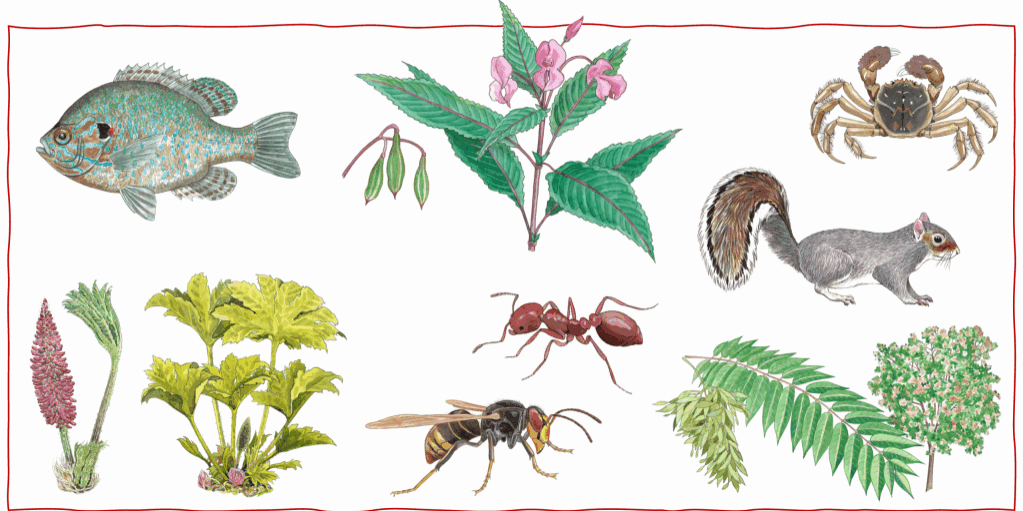How do you solve a problem like Spartina?
This blog was written by Sam Reynolds, Research Associate for BioRISC (the Biosecurity Research Initiative at St Catharine’s) in the Conservation Evidence Group at the University of Cambridge

In conservation we are often faced with difficult decisions. What management actions can we implement to address a threat? Will they be effective? Is this likely to apply in my situation? Deciding upon actions requires weighing up available evidence but assessing and interpreting the complexity of evidence is often challenging.
My role within the Conservation Evidence team is to expand and maintain Metadataset. Metadataset is a tool that allows users to undertake bespoke meta-analyses, with the current focus on improving the effectiveness of invasive species management.
But what is meta-analysis I hear you cry? Meta-analysis is the process of working out, using maths, what the “average” effect of an action might be based on all the existing evidence. It does this by standardising observations made across multiple scientific studies so that observations made by multiple researchers can be directly compared.
For example, many studies may look at the effect of controlled burns to help manage the spread of an invasive plant. Some studies may have measured the weight of plant matter in plots where burning was undertaken, compared to unburned control plots, whereas some may have reported the number of invasive plant stems in quadrats before and after a burning event. While these studies use different methods, they are essentially measuring the same thing: how does burning affect the abundance of this plant?
We can combine these varying observations by calculating what is known as an “effect size”, by capturing observations reported in the literature from both treatment plots and control plots, along with their standard deviations (a measure of how dispersed or spread out the data are) and the number of replicates. These numbers give us an idea of both the magnitude of an effect is and how consistent it is.
In the calculation of “effect sizes”, a greater weight is given to studies where there are a large number of replicates, and to studies where we have a higher certainty in their results (a small standard deviation), as this suggests the observed effect is highly consistent. I spend a lot of my time screening and extracting this data from papers which test control actions on invasive species, to aid the ability of Metadataset to present sound evidence on the effectiveness of invasive species control measures.
On Monday 16th January I opened my inbox to find it flooded with emails. For me, this is unusual. Even more curiously, all the headings consisted of the unmistakably dense and delicate characters unique to the Chinese language. Scattered among these characters was the word Spartina alterniflora. A quick google revealed to me Through my boundless experience in the field of invasion ecology I immediately recognised the significance of this invasive grass, especially in China.
Through digesting the emails, it became clear why there was a palpable sense of urgency. The Chinese government had made a statement earlier that day claiming that they were to remove 90% of a hugely prevalent invasive plant, smooth cordgrass (Spartina alterniflora), from the east coast of China by 2025. An audacious claim indeed. Spartina was introduced to China in 1979, from the USA, to stabilise coastal mudflats for development [1,2]. However, since then it has spread rapidly and now dominates native salt marshes [3], threatens endangered migratory birds [4,5], and has negative impacts on human-food mollusc populations [6].

The kicker was that each of China’s coastal provinces had only six weeks to come up with a plan on how to meet this bold target. The emails were primarily from Professor Bo Li, of Fudan University, an expert in Spartina and its management. He was highlighting that this proclamation by China’s central government was a call to action for Metadataset and that we should co-ordinate an international group of Spartina experts to produce a report summarising the evidence for time-pressed decision makers in China.
Thankfully, due to the hard work of Shengyu Wang, a Masters student in Bo Li’s lab, Metadataset was already primed for the task. Over 8,000 scientific papers and pieces of grey literature had been screened for data detailing the effects of Spartina control methods. Through this process, 116 relevant studies were identified, containing over 3,000 observations. An “observation” refers to a single comparison between a treatment and control plot.
With the data already sitting in Metadataset, our first attempt at the meta-analysis took less than an hour. We cut the data in multiple different ways, looking at the effectiveness of various control methods on Spartina abundance as well as their potential unintended impacts on native plant and animal abundance and diversity. We also split out the data for studies conducted in China, compared to the overall global evidence. Through this initial analysis, it was clear that there were key themes that should be considered by decision makers.

The rapid meta-analyses provided the evidence base and a sense of direction for discussions with a panel of experts on Spartina management, mostly drawn from members of the World Coastal Forum, who provided a sense check of the results. Moreover, their knowledge and on-the-ground experience were crucial for supplementing the review with key contextual considerations for certain management options and valuable case studies on effective implementation.
One of the key challenges in producing this report was balancing the quantitative results of the meta-analysis and the opinions and experiences of experts. This is likely to be a common challenge in producing future rapid analyses for invasive species management, which is the current aim of Metadataset. It is, however, important to include these insights as not all existing evidence on invasive management is appropriate for inclusion in meta-analysis. Equally, meta-analysis alone does not address issues such as the politics or feasibility of a given intervention.
The final report was translated into Chinese and presented by Bo Li, at a meeting hosted by China’s National Forestry and Grass Administration, called to produce technical guidance on Spartina prevention and control. The report has also been featured in an article in Science which addresses China’s decision to banish this alien marsh grass.
Being able to leverage the power of Metadataset to produce this evidence review for a highly impactful and applied purpose was extremely rewarding. Additionally, it highlights the value in having ongoing systematic collation of evidence on invasive species control so that these dynamic meta-analyses can meaningfully assist in decision making processes.
The Spartina Ultrafast Review is available to download from https://osf.io/vpswn/
References
[1] Qin P. & Zhong C.X. (1992) Applied studies on Spartina. Ocean Press, 26, s160–s169.
[2] Qin P., Xie M., Jiang Y. & Chung C.H. (1997) Estimation of the ecological-economic benefits of two Spartina alterniflora plantations in North Jiangsu, China. Ecological Engineering, 8, 5–17.
[3] Wan S., Qin P., Liu J. & Zhou H. (2009) The positive and negative effects of exotic Spartina alterniflora in China. Ecological Engineering, 35, 444–452.
[4] Jackson M.V., Fuller R.A., Gan X., Li J., Mao D., Melville D.S., Murray N.J., Wang Z. & Choi C.Y. (2021) Dual threat of tidal flat loss and invasive Spartina alterniflora endanger important shorebird habitat in coastal mainland China. Journal of Environmental Management, 278, 111549.
[5] Okoye O.K., Li H. & Gong Z. (2020) Retraction of invasive Spartina alterniflora and its effect on the habitat loss of endangered migratory bird species and their decline in YNNR using remote sensing technology. Ecology and Evolution, 10, 13810–13824
[6] An S.Q., Gu B.H., Zhou C.F., Wang Z.S., Deng Z.F., Zhi Y.B., Li H.L., Chen L., Yu D.H. & Liu Y.H. (2007) Spartina invasion in China: implications for invasive species management and future research. Weed Research, 47, 183–191.



